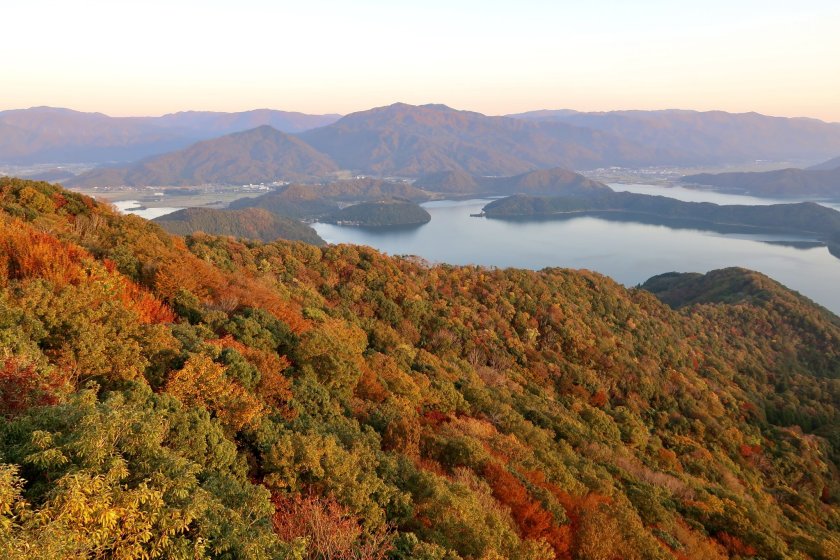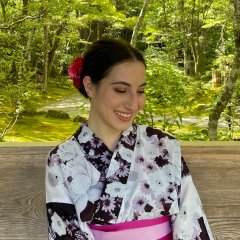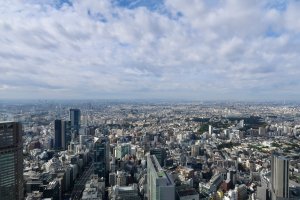With lush countrysides and exciting urban destinations, Japan is filled with adventures for everyone.
Tokyo, the epicenter of Japan’s city culture, is well known for its highrises, flashy lights, and expansive skyline, making it one of the country’s most popular destinations among inbound tourists. However, Tokyo’s cityscape only shows one side of this unique country. Fukui Prefecture, located on Japan’s western border along the Sea of Japan, acts as a wonderful contrast to the fast-paced life of Tokyo. Here, fresh seafood, enchanting nature, temples and shrines, and traditional crafts live in harmony. With its easy connections to Tokyo via Shinkansen and plane (with connections by car), Fukui serves as a wonderful place to explore a lesser known side of Japan.
Join me on an adventure through Tokyo and Fukui, and discover some of Japan’s best kept secrets. Let’s go!
Day 1 - Tokyo
Shibuya Scramble Square

With the expansive Tokyo skyline stretched out before me, I was struck by the commanding presence of this famed city. Buildings of varying heights and hues intersected by busy roads and greenery met the sky at the distant horizon. Where am I, you might ask? The answer is Shibuya Scramble Square! Located beside Shibuya Station and Shibuya Crossing, this 230-meter tall complex features observation decks, offices, shops, and restaurants and is the tallest building in the Shibuya area.

My journey to the sky began on the 14th floor on a unique elevator. During the 30-second ride to the 45th floor, the ceiling of the elevator displayed a show of twinkling lights and ethereal music that made me feel as though I was ascending through space. After securing my loose belongings in a locker, I took a series of escalators to the rooftop Sky Stage. From this open air observatory, I was treated to endless panoramas of central Tokyo. Skyline staples such as Tokyo Skytree, Tokyo Tower, Tokyo Bay, and Yoyogi Park greeted me as I breathed in the crisp autumn air.

I continued my visual adventure on the 46th floor at the Sky Gallery with its floor to ceiling windows, and walked through interactive art exhibits, seating areas, a cafe, a bar, a lounge, and a souvenir shop. After my time among the clouds, I stopped by ocha room ashita ITO EN on the 10th floor and enjoyed a personally-whisked cup of matcha.
Hibiya OKUROJI

From Shibuya Station, I boarded the Ginza Line for a quick 15-minute train ride to Shimbashi Station. Then, after a 5- to 6-minute walk, I reached my next destination—Hibiya OKUROJI. This 300-meter long, underground shopping street runs under eight railway lines and is home to an assortment of restaurants and shops. Constructed in the early 1900s, the combination of white arches and red brick gives the area a modern, yet retro vibe.

As I walked by the numerous storefronts, I spotted an umbrella shop, clothes stores, a shoes store, and even an establishment selling traditional-indigo dyed clothing. As for the food, I allowed my nose to take me on a journey through traditional Japanese and foreign cuisine. At a cute French bakery, I stopped by for a sample of a deliciously sweet canelé. The mundanity of the train operations above coupled with the classy shop fronts below created a unique shopping experience.
Shunju Tsugihagi

After a morning of exploring Tokyo, it was time for some lunch at Shunju Tsugihagi! Fortunately, the restaurant was only about a 5-minute walk from Hibiya OKUROJI. As soon as I entered the restaurant, I was enveloped in a high-end yet welcoming atmosphere. The yellow lighting throughout the restaurant, coupled with the eclectic decor and stonework made for an intriguing interior. In fact, “tsugihagi” translates to “patching”—an ode to the restaurant’s differing styles. I was seated in a simple wooden room and served the autumn lunch course.

This six-course meal featured appetizers crafted with seasonal ingredients, fresh sashimi, sea bream with fig and balsamic sauces, charcoal-grilled wagyu beef paired with salt, a spicy yuzu sauce, and a miso walnut sauce, iron pot rice with pickles and miso soup, and a chestnut cake with fruit. The endless combinations of flavors and textures made for a satiating meal. I paired the meal with a white wine from Yamanashi, which had a smooth and slightly sweet aroma.
Spo-Dori

With a full stomach, it was time to test my physicality at Spo-Dori inside Tokyo Dome City! From Hibiya Station, I took the Toei Mita Line to Suidobashi Station (6 minutes) and then walked about 4 minutes to Tokyo Dome City. The indoor sports facility is home to netted batting and pitching areas, rock climbing, and golf.

When I entered the establishment, the first thing I noticed was a long rock wall to my right. The incline of the rock wall steadily becomes steeper, making it difficult even for adults. With the gratifying thought of conquering the wall, I decided to try rock climbing! Once I rented some shoes and purchased a ticket from the front desk, I was ready to go. As I stood below the wall, even the beginner climb started to look daunting. Even so, I persevered. With full concentration, I moved purposefully through each step and after a few falls, successfully made it to the top. The experience was fulfilling and challenging—a great way to add variety to a day of sightseeing.
Kagurazaka Kamosho

After some rest and relaxation, I headed to my last stop of the day—dinner at Kagurazaka Kamosho. Kagurazaka is a popular shopping and restaurant district near Iidabashi Station renowned for its sloping street. In the darkness of the autumn evening, the shops lining the main street emitted an aesthetic glow as passersby enjoyed the cool air. After a few minutes on the main street, I turned down a narrow, cobblestone pathway to the restaurant. The front of the establishment was decorated with a dark noren (Japanese curtain) and I was required to remove my shoes after entering.

Kagurazaka Kamosho specializes in duck dishes, so I ordered the shabu shabu duck course. This multi-course meal featured a variety of dishes, including fish, tofu, and vegetables seasoned with truffle salt, wasabi, fig, mustard, and more. However, the main star was the duck. With a fire flickering under a hearty bowl of duck broth, the waiter brought me a plate of thinly sliced duck meat, which I cooked myself by dipping it in the soup. Each freshly cooked piece filled my mouth with warm and savory flavors.

I paired the meal with a Chiba-produced sake to round off the rich aromas.
Day 2 - Fukui
Ootoku

The next morning, I started my day with a one-hour flight from Haneda Airport in southern Tokyo to Komatsu Airport in Ishikawa Prefecture. From there, I met with my guide, who had a rental car, and we drove south to the neighboring prefecture Fukui! After about a 45-minute drive, we reached our first stop—Ootoku, a seafood restaurant located along the Sea of Japan.

The staff seated me at a second-floor table beside a massive window that offered captivating views of the sparkling tide and gentle waves, as well as nearby Oshima Island. The interior’s simple wooden design conveyed a rustic, yet modern vibe, and perfectly complemented the encircling oceanscape.

After pursuing the seafood and meat-filled menu, I settled on maguro don, a tuna rice bowl. The raw tuna was arranged atop a bowl of fluffy rice and garnished with wasabi, pickled ginger, and a piece of egg roll. The dish was paired with pickled cabbage, miso soup, and a mild-flavored white fish called karei. I could not suppress the smile that brightened my face as I took a bite of the fresh tuna.
Tojinbo and Oshima Island

After enjoying the flavors of the sea, it was time to explore one of Fukui’s most renowned sightseeing spots—Tojinbo. From the restaurant, we drove about five minutes to a nearby parking lot and then walked another five minutes along a retro street reminiscent of Japan’s Showa period. The nostalgic path was lined with eateries and souvenir shops where the savory aromas of seafood intermingled with the ocean breeze.

Once I reached the shoreline, the majestic view took my breath away. Jagged, yet oddly geometrical cliffs met the calm tide in a mesmerizing display of nature. The expansive ocean served as a wondrous backdrop to the scene as frothy white waters pooled around the unique rock formations. I closed my eyes and inhaled the crisp wind and felt myself relax in tune with the waves’ lullabies. The paths around the cliffs are easy to navigate, but be sure to wear comfortable shoes!

Then, I hopped back in the car for another five minute drive to a parking lot near Oshima Island. This tiny, uninhabited island is located just off Fukui’s coast and is connected to the mainland by a picturesque red bridge. As I walked toward Oshima, the island’s lush greenery, visually intriguing rockside, and white torii gate made me feel as though I was walking into another world. The island takes about one hour to walk around and is home to a shrine, lush nature, and stunning ocean views.
Heisenji Hakusan Jinja Shrine

Next, we traveled inland to Heisenji Hakusan Jinja. The car ride took about one hour and was filled with warming views of autumn colored mountainsides, agricultural fields, and quaint villages.

Once we reached the shrine, I was once again swept into a mystical world. The locally-beloved shrine, nicknamed “the Temple of Moss,” is famous for its thick carpet of moss and has long been a base of worship for Hakusan—one of Japan’s most sacred mountains. With stone pathways at my feet and shrine structures seamlessly interwoven into the scenery, I was entranced by the peaceful balance of nature and spirituality. Towering trees guided my every step, and the verdant moss-covered landscape lulled me into utter contentment.

The woods were extremely quiet—apart from the light breeze, occasional chirping crickets, and my own echoing footsteps—and enveloped me in serenity that persevered the remainder of the day.
Dinner at Awara Onsen Haiya

With calm minds, we drove about one hour to my accommodation for the night—Haiya in Awara Onsen. Awara Onsen is one of the most popular hot spring towns in central Japan and is home to a variety of ryokan, or traditional Japanese inns. Once I arrived at Haiya, the staff guided me to my room and kindly showed me how to wear a yukata, which is a lighter and casual type of kimono. After dressing in the traditional attire, I slipped on some hotel-provided sandals and made my way to the dining room, which featured multiple private rooms divided by wooden barriers.

A smiling server brought me my first course—a persimmon filled with cucumber and crab paired with umeshu (Japanese plum liqueur). This sweet and savory dish was followed by a slew of delicious food, including soup, fresh sashimi, an apple stuffed with salmon and cheese, Wakasa beef, fried sesame tofu, daikon radish filled with fish, a spring roll with crab and wasabi jelly, and montblanc with fruit. Each dish was artistically plated and featured a wealth of unique textures and flavor combinations that matched the refined nature of the ryokan.
Awara Onsen Haiya

At Haiya in Awara Onsen, I felt as though I traveled back in time to traditional Japan. Each room and hallway aesthetically epitomized Japanese refinement with woodwork, neutral colors, and traditional decor. My room itself, was a Japanese-styled room and featured tatami floors, sliding shoji doors, and large windows with views of a small Japanese garden. During dinner, staff came to my room and set up a futon for me to sleep on. The attached bathroom acted as an extension of the beautifully designed space and even had its own private hot spring bath!

After a long day of traveling and sightseeing, I felt myself truly unwind in the steaming and rejuvenating waters. Aside from the personal bath, the ryokan also had an equally relaxing communal bath. Along with the traditional touches, the hotel also offered modern conveniences such as Wi-Fi, small lockers for personal items, a mini fridge with beverages, a hair dryer, and more. The experience was further enhanced by the exceptional hospitality of the staff.

The following morning, after a traditional washoku-style breakfast featuring vegetables, fruit, rice, rolled egg, fish, and miso soup, the staff heartily waved goodbye as I started the new day.
Day 3 - Fukui
Eiheiji Temple

I started my last day in Fukui with a visit to Eiheiji Temple, which was about a 45-minute drive from the ryokan. Upon our arrival, we parked in a nearby parking lot and walked about five minutes through a quaint temple town to Eiheiji. The moment I caught sight of the Buddhist temple complex, I was struck by its commanding, yet comforting presence, and after trading my sneakers for a pair of temple slippers, I was ready to start exploring.

Traditional wooden buildings and lanterns sat in perfect harmony with the area’s flourishing nature as autumn’s blessings colored the grounds in a vibrant array of colors. As I toured the numerous structures, I was captivated by the significance and hidden meaning behind everything—from the placement of buildings to the posture of statues. In fact, the entire complex itself is laid out to represent a Buddha performing zazen, or meditation.

In contrast to Heisenji Hakusan Jinja Shrine’s solitude, Eiheiji was an extremely active temple filled with monks carrying out daily practices. During my trip, I was honored to witness a funeral service. Although I could not understand what the monks were saying, I was overcome by the powerful energy of the synchronized chanting. The gentle atmosphere of Eiheiji touched me and left me with a deeper understanding of the Soto sect of Buddhism.
Lunch at Kamezo Soba

After about two hours of exploring Eiheiji, I was ready for some lunch! From the temple, we drove about 30 minutes to Kameza Soba for one of Fukui’s most popular dishes—echizen oroshi soba. The restaurant’s wooden interior and warm lighting created a welcoming atmosphere, and I was seated at a traditional Japanese table.

My mouth watered as the server brought me my dish—a plate of cold, 100% buckwheat soba served with a grated daikon-broth sauce and seafood tempura. As instructed by my guide, the proper way to enjoy the dish was to first try the soba alone and then pour the sauce on top. As I bit into the firm noodles, an earthy and nutty flavor filled my mouth. The soba had a satisfying chew and paired wonderfully with the mellow aroma of the broth and crunchy tempura. I finished off my meal with a cup of hot sobayu (soba water)—a typical beverage served after soba.
Takefu Knife Village

After enjoying Fukui’s culinary arts, it was time to explore its industrial side at the Takefu Knife Village in Echizen City—a short 15-minute car ride from the restaurant. For the past 700 years, Echizen has excelled at forging high quality knives.
My tour of the facility started in the main cylindrical building where I observed displays of cooking and agricultural knives, as well as profiles of master artisans whose ages ranged from 18 to 82! Next, we headed to the main attraction—the workspace.

The moment I opened the door, the sound of crunching metal and smell of iron manufacturing filled the air. From the second floor balcony, I eagerly watched the focused workers pound and shape iron. The dense landscape of machinery made for a visually intriguing viewing experience no matter where I looked. Here, traditional methods existed alongside modern ones, and workers from all over Japan forged beside one another. The facility even housed a shrine dedicated to the founder of the craft!

As I moved to the adjoining shop to observe the knives up close, I was mesmerized by their detailed craftsmanship. The knives were more than just tools—they were pieces of art that represented centuries of cultural heritage.
Rainbow Line Summit Park

As the sun started its descent, we drove about an hour to our last spot—the Rainbow Line Summit Park, a mountaintop park. From the park’s base, I hopped on a single-seated lift and slowly ascended the hillside. During the journey, giddiness swelled in my chest as I gaped at the surreal landscapes. At the top, I could no longer contain my excitement as I bounded to the park’s eastern edge. The view was indescribable. Autumn clothed mountains rested in the expansive Mikata Five Lakes as the setting sun bathed the scenery in a golden hue.

After enjoying the lakeside views, I rushed to the other side of the park for sweeping views of the Tsuruga Peninsula against the Sea of Japan. No matter where I looked, I was treated to dreamlike panoramas. A colorful rose garden decorated the park’s sea side and allowed me unique views of the ocean between multicolored petals. Aside from the breathtaking views, the park’s summit was also home to a cafe, a shrine, and an open-air footbath.

As the sun reached the horizon, amber skies sparkled on the gentle tide and highlighted the silhouettes of the surrounding naturescape. I smiled. The view was not one I would soon forget.
Shinkansen Time
With darkness blanketing the Fukui countryside, we drove about an hour to JR Maibara Station in Shiga to catch the Tokaido Shinkansen to Tokyo Station. After settling in my large train seat by the window, I watched as Japan’s natureside gave way to Tokyo’s skyscrapers. The journey took about two hours and 15 minutes.
What a Trip!
My Japan adventure started with panoramas of central Tokyo and ended with breathtaking views of Fukui’s nature. While completely different, both views illustrated the diverse beauty of Japan. Fukui’s lush nature and traditional charm acted as a wonderful contrast to Tokyo’s urban delights. Throughout my travels, I enjoyed delectable cuisines, natural beauty, unparalleled hospitality, and cultural wonders. I look forward to visiting Fukui again in the future!
We hope to see you soon!
































